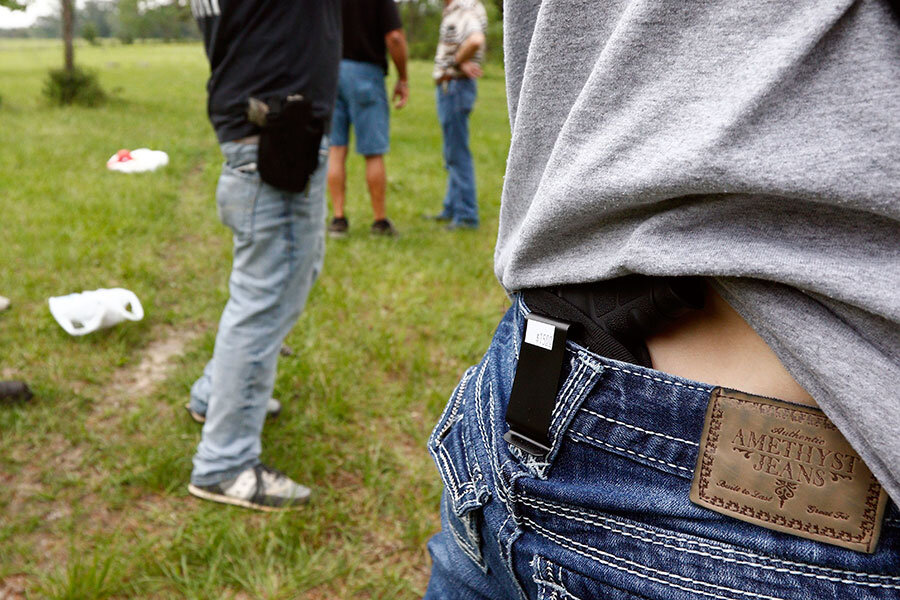Second Amendment ruling: Which concealed carry laws affect you?
| Atlanta
Here in Atlanta, a person can walk into Hartsfield-Jackson International Airport with a concealed gun in a case – or for that matter, a loaded assault-style rifle carried openly. As long as the person is licensed, there’s nothing the police can do.
In Los Angeles, however, walking outside your home with a concealed gun remains illegal unless authorities have decided you have “good cause” to carry.
A major Second Amendment decision on Thursday from the Ninth Circuit Court of Appeals intensified – and perhaps enshrined – this growing divide across the United States in how, where, and why Americans may carry weapons in public.
In a 7-to-4 en banc decision, the Ninth Circuit ruled that authorities in California and eight other states under its jurisdiction can control who may carry concealed guns in public.
“Because the Second Amendment does not protect in any degree the right to carry concealed firearms in public, any prohibition or restriction a state may choose to impose on concealed carry – including a requirement of ‘good cause,’ however defined – is necessarily allowed by the Amendment,” Judge William Fletcher wrote for the majority in the decision in Peruta v. San Diego.
The ruling may ultimately head to the United States Supreme Court. In its D.C. v. Heller ruling, the high court determined that armed self-defense in the home is permissible under the Second Amendment. Ultimately, it may feel compelled to weigh in on the extent to which government can regulate gun carry outside the home.
On the other hand, the ruling also leaves an easy out for the high court to let the status quo stand, thus affirming the power of states to interpret federal law in distinct ways, even on issues of deep national interest.
“One thought is that the Constitution needs to be nationalized, but others are comfortable saying that the values of the citizens of Louisiana are very different than those of New York,” says John Vile, a constitutional scholar at Middle Tennessee State University in Murfreesboro. “It’s the whole ‘e pluribus unum’ [‘out of many, one’] conundrum: pluribus or unum, which is it?”
According to Professor Vile, author of “Pleasing the Court,” the struggle by many conservatives to make America’s patchwork gun laws more federally uniform upends a traditional political balance. Usually, it’s liberals who push for more federal protections for citizens, while conservatives mostly support the right of states to establish laws that abide by regional standards and mores.
Today, California, Hawaii, and some Northeastern states retain the right to decide who gets to carry concealed weapons in public. The vast majority of middle-American states, in a sharp shift from the early 1980s, presume the opposite, that everyone, barring legal or mental problems, has a basic right to concealed carry a gun. And gun rights have been increasingly liberalized, with 45 states having some form of open carry law on the books, although some include restrictions on either long guns or handguns.
In that light, the Ninth Circuit ruling was a “big” victory for gun control advocates, in part by affirming the constitutionality of restrictive conceal-carry in California’s big cities while also making it “less likely the Supreme will step in” to further nationalize gun rights, given that there’s now no conflict over the issue among the appeals circuits, Adam Winkler, a law professor at the University of California, Los Angeles, tells the Los Angeles Times.
The ruling affirmed the right of the state to have authorities determine what constitutes “good cause” to carry a concealed weapon.
Gun rights advocates say the problem in California is that the state also bars the open carry of weapons.
Taken together, those tough gun control rules, in effect, amount to “a total ban on the right of an ordinary citizen to carry a firearm in public for self-defense,” Judge Consuelo Callahan wrote in a dissent. She added: “While states may choose between different manners of bearing arms for self-defense, the right must be accommodated.”
In California, the ruling allows sheriffs in rural counties to make more accommodations for those who want to shoulder a rifle in the high mountain country versus urban law enforcement agencies, who maintain that more guns on city streets make those streets more dangerous.
As California Attorney General Kamala Harris wrote in a brief to the court, California, for its part, wants to retain “the legislative judgment that allowing the essentially unrestricted carrying of handguns [outside the home] makes the public, on balance, less safe.”
As the Ninth Circuit agreed with that assessment on Thursday, one major take-away is that the verdict suggests that the US may have reached equilibrium on gun rights. In other words, any eventual ruling by the Supreme Court is likely to have only a marginal effect on the checkerboard status quo.
“The Supreme Court, with existing cases, could easily go in either direction without causing too much of a ripple: It can either say we said from the beginning there were going to be restraints; or that you can’t have the restraints [be so onerous] as to effectively deprive you of the right” to bear arms, says Vile.







